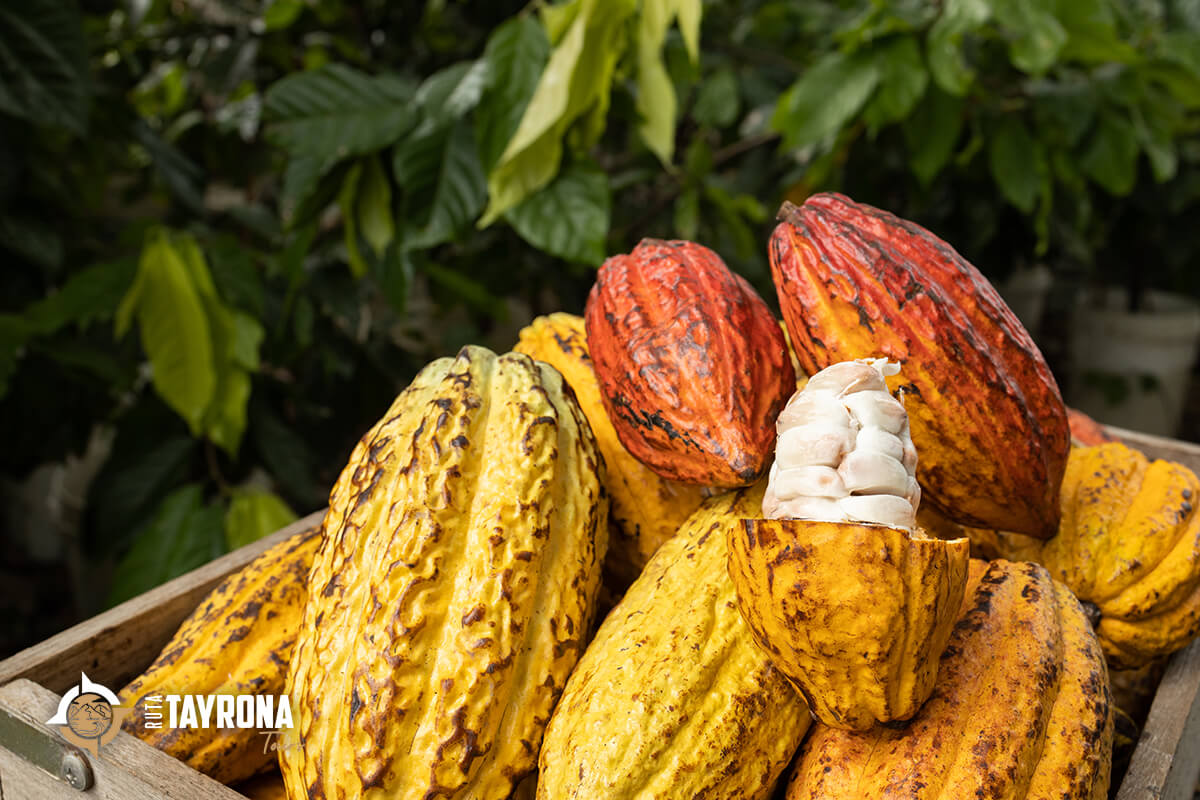Day Trip
Discover the mysteries of cocoa on our Chococerrano tour.
It's more than just a hike; it's a historical, natural, and adventurous immersion.

The Sierra Nevada de Santa Marta, a majestic mountain range that rises above the Caribbean coasts of Colombia. It holds a rich historical and cultural tradition related to one of the most beloved and valuable products in the world: cacao.
In this blog, we will explore the fascinating history of cacao in the Sierra Nevada de Santa Marta, from its ancestral roots to its importance today.
The history of cacao in the Sierra Nevada de Santa Marta dates back to pre-Columbian times. Ancient indigenous civilizations such as the Tayrona, Kogui, Arhuacos, Kankuamos, and Wiwa cultivated and revered cacao as a divine gift. They considered it a food of the gods and used it in religious ceremonies and rituals.
With the arrival of Spanish colonizers, cacao became a coveted export product. The conquistadors saw cacao plantations as an opportunity to generate wealth and power. Through slavery, indigenous people were forced to work on cacao plantations, which had a devastating impact on their cultures and communities.
Cacao production in the Sierra Nevada was fluctuating, and the quality of cacao greatly deteriorated due to the lack of investment and modernization. In recent decades, there has been a resurgence in the production of high-quality cacao in the region. Local farmers and organizations have focused on sustainable production, respecting indigenous traditions and protecting the natural environment.
Cacao remains a fundamental part of the culture and economy of the Sierra Nevada de Santa Marta. Indigenous communities continue to cultivate it and use cacao in their rituals and festivals. Additionally, the cacao from the region has gained international recognition for its flavor and quality, boosting the local economy and promoting biodiversity conservation.
is a fascinating narrative that spans centuries of change and resilience. From its sacred roots in indigenous cultures to its revival as a quality and sustainable product. Today, this story continues to evolve as local communities and chocolate enthusiasts worldwide value and support the cacao from the Sierra Nevada de Santa Marta. Cacao is just one of the many stories this region has to tell, but it is undoubtedly one of the sweetest and most meaningful.
The city was composed of terraced steps and stone structures that served as homes, ceremonial spaces, and areas for daily activities.
Book the 4 days 3 nights tour here.
The reason behind the abandonment of Ciudad Perdida is still not entirely clear, but it is believed that factors such as internal conflicts, diseases, or even climatic events may have contributed to its decline. The arrival of the Spanish conquistadors in the 16th century marked the end of the Tayrona civilization and the beginning of a gradual disappearance of the city in the jungle.
Ciudad Perdida remained forgotten for centuries, shielded by the dense vegetation and geographic isolation of the region. It wasn’t until the 1970s that a group of looters discovered the site. Colombian authorities and archaeologists quickly became involved in its study and preservation.
Today, Ciudad Perdida is a destination for adventure and archaeological tourism. Visitors must embark on a multi-day trek through the jungle to reach the site, following ancient trails and crossing rivers. The experience provides a unique insight into the history and culture of the Tayrona people, as well as the opportunity to explore the structures and terraces that make up the city.
Ciudad Perdida serves as a reminder of the rich cultural diversity that existed in the Americas long before the arrival of Europeans. Its rediscovery has allowed present generations to connect with a past that had been buried in time and the lush nature of the Colombian jungle.
Reserva el tour de 4 dias 3 noches aqui.
Immerse yourself in a journey through time and nature as you explore the ancient archaeological wonder of Ciudad Perdida, also known as Teyuna. This exciting tour will take you through ancestral trails, tropical jungles, and intriguing archaeological ruins, providing you with an experience that combines adventure with history.
Your journey begins at the base of the Sierra Nevada de Santa Marta, where you will meet your group and guide. From here, you will embark on an exciting vehicle journey to Machete, the gateway to the Sierra Nevada de Santa Marta. It’s a small hamlet nestled on the slopes that mark the beginning of the imposing Sierra Nevada de Santa Marta. It was in this very corner and moment when the ancestral magical power began its influence.
The Sierra Nevada de Santa Marta is home to multiple communities that share cultural and philosophical similarities in their relationship with nature. These communities have established a symbiosis with the ecosystem and have passed down this knowledge. Before embarking on any journey in the area, a fundamental principle is to show deep respect for natural resources.
Start of the Trek to Lost City
After a brief informational session and preparation, you’ll embark on an exciting hike through ever-changing landscapes, from crystal-clear rivers to dense jungles. During the journey, you’ll be surrounded by unique flora and fauna, and you’ll have the opportunity to interact with local communities.
After an exhausting 4.5-hour hike, you will finally reach the first campsite, nestled in the heart of the jungle and by the banks of a stream. You will sleep in an open-air wooden cabin with a thatched roof, surrounded by lush jungle.
Once settled at the campsite, it’s time for a well-deserved bath, followed by a meal prepared on-site over a wood-burning stove.
Fatigue suggests that it’s time to rest. Insects will whisper and serenade you throughout the night with their outdoor symphony. It will be a very relaxing moment, as if the jungle and the night were quietly offering you guidance.
You can look forward to a wake-up filled with sounds in the midst of the majestic Sierra Nevada de Santa Marta.
The second day takes you deeper into the jungle as you follow in the footsteps of the ancient Tayrona people. You will traverse challenging but rewarding terrain, with waterfalls and panoramic views as your rewards. Your guide will share stories about Tayrona culture and help you appreciate the rich history surrounding the Lost City.
You’ll wake up to a cup of coffee that you can enjoy while looking towards the mountains and imagining the Lost City. You’ll savor a delicious Colombian breakfast and then start your hike, where you’ll enjoy the flora and fauna, cross rivers, and eventually reach the next campsite.
Today is the day! After days of exploration, you will finally reach the ruins of the Lost City. You will be breathless at the sight of the terraced platforms, stone structures, and petroglyphs that tell ancient stories. Your guide will take you on a tour of the site, sharing information about life in the city and its mysterious decline.
On the way, you will meet different indigenous communities and have the opportunity to delve into knowledge about their cultures and traditions.
They will receive you and welcome you, telling you about their history and philosophy, and they will also ask you questions about your life.
The ascent through 1,600 steep steps will begin to reveal the majesty of the place. Among the dense jungle, some terraces and stone remains will start to emerge. It’s immense! Could you ever have imagined that such massive ruins were hidden under the jungle’s protection?
You will learn about its history and enjoy the place for approximately 4 hours.
Your last morning in the Lost City gives you time to absorb the energy and history that permeate the place. After saying goodbye to this unique site, you will begin the journey back, taking the opportunity to reflect on your experience and everything you have learned.
You will embark on the hike back to the starting point (Machete) where you will have a delicious regional lunch. Afterward, we will begin the return journey to the city of Santa Marta, letting the memories and good times flow and be stored in your heart to keep them always present.
Reserva el tour de 4 dias 3 noches aqui.
This tour to the Lost City is much more than a simple hike. It’s an immersion into history, nature, and adventure. If you’re ready to challenge yourself, explore an ancient legacy, and create lasting memories, this tour is an exciting choice.
It's more than just a hike; it's a historical, natural, and adventurous immersion.

Copyright – 2025 – Ruta Tayrona Tours – All rights reserved. Powered by Estructurando